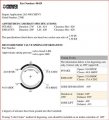keep in mind when viewing the head flow graph posted above ,
that there are other , important factors in any engine combo,
head flow is critical but it must match the other parts selected,
those brodix 200 heads are known to make good power, now looking at the graph, you might think, they can,t compete,
but if your intake manifold only flows lets say 260 cfm they may be the hot ticket!
its not the individual part but the total combo that maters,
few dual plane carburetor intakes exceed 270 cfm in individual runner flow
http://garage.grumpysperformance.com/index.php?threads/carburetor-intake-manifold-test.58/
http://garage.grumpysperformance.co...ing-parts-and-a-logical-plan.7722/#post-85144
http://garage.grumpysperformance.co...e-springs-and-setting-up-the-valve-train.181/
http://garage.grumpysperformance.com/index.php?threads/is-backpressure-hurting-your-combo.495/
http://garage.grumpysperformance.com/index.php?threads/calculating-required-exhaust-pipe-size.11552/
if your intake won,t flow 270 you heads can,t be expected to exceed that flow rate,
if your auto transmission shifts at 5700 rpm it does not hardly mater if you are basing choices
on engine port flow you might see at 6700 rpm
Id also point out the exhaust scavenging,
and cam timing has a pronounced effect on intake port flow,
at lower and mid range engine rpms max head port flow is seldom reached.
yes you should get the best heads you can afford, but posted flow rates are seldom achievable,
without extensive intake porting modifications , proper cam timing and an open long tube tuned header.
theres an old sawing... "a chains only as strong as its weakest link"
with engine durability and air flow a similar process is involved.
one tip youll learn over time is that your generally better off buying fewer high quality parts,
than more lower quality parts, and all the parts used,
must match the intended rpm , stress levels and power range.








